-
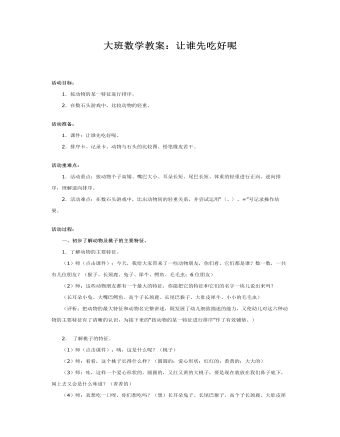
大班数学教案:让谁先吃好呢
活动准备:1.课件:让谁先吃好呢。2.排序卡、记录卡、动物与石头的比较图、铅笔橡皮若干。活动重难点:1.活动重点:按动物个子高矮、嘴巴大小、耳朵长短、尾巴长短、体重的轻重进行正向、逆向排序,理解逆向排序。2.活动难点:在数石头游戏中,比出动物间的轻重关系,并尝试运用“〈、〉、=”号记录操作结果。活动过程: 一、初步了解动物及桃子的主要特征。1.了解动物的主要特征。 (1)师(点击课件):今天,我给大家带来了一些动物朋友,你们看,它们都是谁?数一数,一共有几位朋友?(猴子、长颈鹿、兔子、犀牛、鳄鱼、毛毛虫;6位朋友) (2)师:这些动物朋友都有一个最大的特征,你能把它的特征和它们的名字一块儿说出来吗? (长耳朵小兔、大嘴巴鳄鱼、高个子长颈鹿、长尾巴猴子、大肚皮犀牛、小小的毛毛虫) (评析:把动物的最大特征和动物名完整讲述,既发展了幼儿细致描述的能力,又使幼儿对这六种动物的主要特征有了清晰的认识,为接下来的“按动物的某一特征进行排序”作了有效铺垫。)2.了解桃子的特征。 (1)师(点击课件):咦,这是什么呢?(桃子) (2)师:看看,这个桃子长得什么样?(圆圆的;爱心形状;红红的;黄黄的;大大的) (3)师:哇,这样一个爱心形状的、圆圆的,又红又黄的大桃子,要是现在就放在我们鼻子底下,闻上去又会是什么味道?(香香的) (4)师:真想吃一口呀,你们想吃吗?(想)长耳朵兔子、长尾巴猴子、高个子长颈鹿、大肚皮犀牛、大嘴巴鳄鱼、小小的毛毛虫和我们一样,看到这个桃子,馋得口水都快流出来了,都想先吃到这个大桃子。 (评析:对桃子形状、颜色、大小特征的讲述,以及对桃子气味的猜测,既“勾”起了幼儿品尝桃子的欲望,又“唤”起了他们对动物看到桃子后急切品尝心境的理解,适时、巧妙的引出了本次活动的一条暗藏线索“让谁先吃好呢?”。)二、按动物的某一特征排序。1.按动物高矮、大小、长短排序。 (1)按个子的高矮排序。A.师(点击课件):“按照个子的顺序吃怎么样?”长颈鹿把脖子挺得直直的,先说了一句。那就得先量量看,谁的个子最高了。毛毛虫说:“不能站在高的地方量,量的时候不能把尾巴算上”小兔说:“踮起脚来量也不行。”B.师(点击课件):瞧,他们每人都找了一棵大树开始量了起来。动物们和大树的什么比?(树干)C.师:它们一个个都紧贴着树干,认真的量着。小朋友,你们看出来了吗?谁最高?第二高是谁呢?第三高呢?接下来轮到谁?第五高?最矮的一个是谁呀?D.出示高矮排序图。E.讲述故事:“看见了吧?看见了吧?我的个子最高,所以得我先吃!”长颈鹿把脖子伸得长长的,刚要去咬那个又大又红的桃子。 (2)按嘴巴的大小排序。A.师(点击课件):“不行,这么大的桃子,当然得嘴巴最大的先吃了”鳄鱼张着一张大嘴,站了出来。到底谁的嘴巴最大?B.师(点击课件):“我的嘴巴大!”(犀牛声音)“谁说的!我的嘴巴才是最大的呢!”(鳄鱼声音)C.师:你们说,谁的嘴巴最大?(鳄鱼)E.讲述故事:“听见没,听见没有?我的嘴巴最大,当然是我先吃了!”鳄鱼使足了全身的劲儿,张大嘴巴,马上就要咬到这个又大又红的桃子了…… (3)按耳朵的长短排序。A.师(点击课件):“这么做不行!”蹦蹦跳跳的兔子竖着耳朵跑过来。B.师:欸,兔子会说什么呢?(谁耳朵长谁吃)C.师:那就是说得按什么顺序来吃桃子?(长短顺序)D.师:按什么的长短顺序,谁能完整的说一说?(按耳朵的长短顺序吃)E.师(点击课件):对,应该按照耳朵长短的顺序、谁的耳朵长谁先吃!那就比比,看看到底谁的耳朵最长吧。“看,还是我的耳朵最长吧!”小个子的兔子好不容易够到长颈鹿的脖子,说道。

大班数学教案:7的组成
2、通过讨论、分析,理解一个数分成两个部分,如一个不风增加1,另一个部分就要减少1。 活动准备 塑料小鸭学具人手42只。 活动过程 一、复习6的组成 玩“碰球游戏”,出现数咔,师问:这数是几?答“6”。师:今天玩碰游戏,教师与小朋友的数合起来是6。(例如),师:我的1球碰几球?答:你的1球碰5球)教师问,小朋友可集体回答,也可小组回答,也可个别回答。 二、集体尝试活动
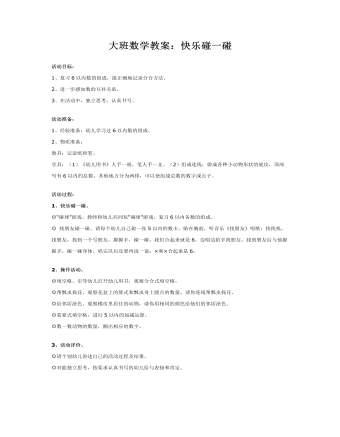
大班数学教案:快乐碰一碰
2、进一步感知数的互补关系。 3、在活动中,独立思考,认真书写。 活动准备: 1、经验准备:幼儿学习过6以内数的组成。 2、物质准备: 教具:记录纸和笔。 学具:(1)《幼儿用书》人手一册,笔人手一支。(2)组成连线:做成各种小动物形状的底纹,顶部写有6以内的总数,其他地方分为两排,可以使组成总数的数字或点子。 活动过程: 1、快乐碰一碰。 ◎“碰球”游戏。教师和幼儿共同玩“碰球”游戏,复习6以内各数的组成。 ◎找朋友碰一碰。请每个幼儿自己做一张5以内的数卡,贴在胸前,听音乐《找朋友》唱歌:找找找,找朋友,找到一个号朋友,握握手,碰一碰,我们合起来就是6。边唱边拍手找朋友,找到朋友后与他握握手,碰一碰身体。唱完以后还要再说一说:×和×合起来是6。
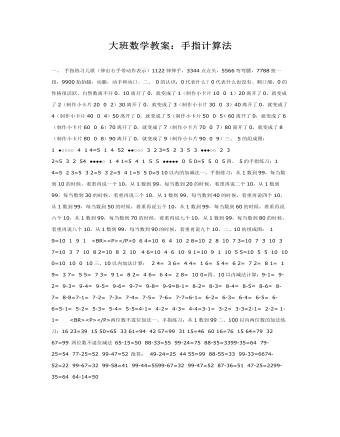
大班数学教案:手指计算法
一、手指练习儿歌(伸出右手带动作表示)1122伸伸手,3344点点头,5566弯弯腰,7788扭一扭,9900抬抬腿,动腿,动手和动口。二、 0的认识:0代表什么?0代表什么也没有。顺口溜:0的性格很活跃,自然数离不开0。10离开了0,就变成了1(制作小卡片10 0 1)20离开了0,就变成了2(制作小卡片20 0 2)30离开了0,就变成了3(制作小卡片30 0 3)40离开了0,就变成了4(制作小卡片40 0 4)50离开了0,就变成了5(制作小卡片50 0 5)60离开了0,就变成了6(制作小卡片60 0 6)70离开了0,就变成了7(制作小卡片70 0 7)80离开了0,就变成了8(制作小卡片80 0 8)90离开了0,就变成了9(制作小卡片90 0 9)三、 5的组成图:1 ●○○○○ 4 14=5 1 4 52 ●●○○○ 3 23=5 2 3 5 3 ●●●○○ 2 32=5 3 2 54 ●●●●○ 1 41=5 4 1 5 5 ●●●●● 0 50=5 5 0 5
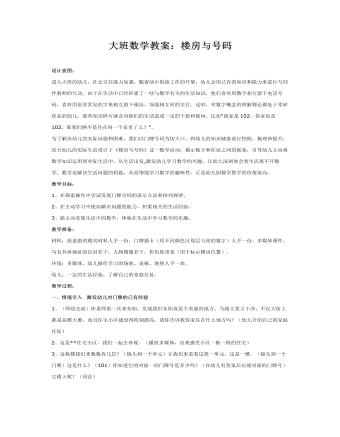
大班数学教案:楼房与号码
为了解决幼儿的实际问题和困难,我们以门牌号码为切入口,将幼儿的知识储备进行挖掘、梳理和提升,结合幼儿的实际生活设计了《楼房与号码》这一数学活动,揭示数字和住址之间的联系,引导幼儿主动将数学知识运用到实际生活中。从生活出发,激发幼儿学习数学的兴趣,让幼儿深刻体会到生活离不开数学,数学是解决生活问题的钥匙,从而增强学习数学的趣味性,正是幼儿园数学教学的价值取向。教学目标:1、在探索操作中尝试发现门牌号码的表示方法和排列规律。2、在主动学习中提高解决问题的能力,积累相关的生活经验。3、能主动发现生活中的数学,体验在生活中学习数学的乐趣。教学准备:材料:纸盒做的楼房材料人手一份,门牌插卡(用不同颜色区别层与间的数字)人手一份,多媒体课件,写有具体地址的信封若干,人物图像若干,彩色胶带卷(用于标示楼房位置)。环境:多媒体、幼儿操作学习的场地、桌椅、地垫人手一块。幼儿:一定的生活经验,了解自己的家庭住址。
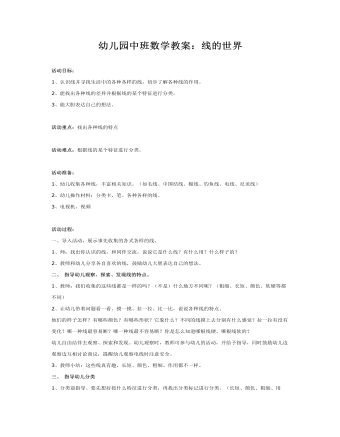
中班数学教案:线的世界
活动重点:找出各种线的特点 活动难点:根据线的某个特征进行分类。 活动准备:1、幼儿收集各种线,丰富相关知识。(如毛线、中国结线、棉线、钓鱼线、电线、尼龙线)2、幼儿操作材料:分类卡、笔、各种各样的线。3、电视机、视频 活动过程:一、导入活动,展示事先收集的各式各样的线。1、师:找出你认识的线,和同伴交流,说说它是什么线?有什么用?什么样子的?

中班数学教案:会变的图形
教学准备: 正方形纸、小刀。 教学过程: (一)变魔术 让幼儿猜想正方形能不能变成三角形、小正方形、长方形。然后将纸折叠,剪开变为各种图形。 将剪开的图形再拼成正方形。

新人教版高中英语必修2Unit 2 Wildlife Protection-Reading For Writing教案一
1. 标题首先根据海报的特点、格式写明标题。海报中往往把内容作为大标题。例如: Save the earth, Save the birds。2. 正文部分不同的海报其正文部分的侧重点不同。对于介绍性的海报, 首先要引出话题, 其次列出原因, 最后是总结。对于宣传类的海报, 要写明具体内容, 如: 活动内容, 地点以及参加活动的注意事项, 主持或举办单位等。1. 图片: 要选择引人注目的图片, 与主题要相关, 色彩明亮。话题句式 1. It is a treasure of our country. 它是我国的国宝。2. Believe it or not, at present only several thousand pandas exist in the world. 信不信由你, 目前世界上仅现存几千只熊猫。 3.It’s because of human activities that tigers are endangered. 正是因为人类的活动, 老虎处于濒危的状态。4. Many wild animals are in danger of dying out. 很多野生动物面临着灭绝的危险。 5. The government has taken effective measures to protect them. 政府已采取有效的措施来保护它们。6. People should raise the awareness of the protection of wild animals. 人们应该提高保护野生动物的意识。 7. It’s amazing that there are merely less than 1, 000 finless porpoises living in China. 非常令人吃惊, 目前中国仅有不足1 000只江豚。

新人教版高中英语必修2Unit 2 Wildlife Protection-Reading for Writing教案二
This lesson aims at making a poster about protecting wildlife after reading some posters. During reading students are guided to understand the content and try to summarize the posters with one sentence. Then students are guided to try to make a poster about protecting wildlife.1. Read the two posters and try to understand the summary sentences.2. Look at the two posters and try to understand what emotions they express.3. Try to summarize the features of posters4. Try to make a poster about wildlife.1. Look at the two posters and try to understand what emotions they express.2. Try to summarize the features of posters3. Try to make a poster about wildlife.Step 1 Lead inLook at the the posters on the textbook and ask:Which emotions do the posters communicate ?Step 2 Read the poster and answer the questions.1. What do you think of the animals in the poster on the left ?I think it is frightening and ugly.2. Why do we should protect the ugly animals ?All species--the good, the bad, and the ugly-- should be treated equally.The world needs all kinds--without variety, our planet cannot survive.3. Why are billions of trees being cut down every year ?To make paper for humans.4. What result will be lead to after the trees are cut down ?A lost of animal homes are being destroyed./The habitat of wildlife is being destroyed.Step 3 Find the feature of posters1. What does each poster use to stir up emotions ?On the left, it makes us a little frightened and it looks a little ugly, but it can activate our curiosity--What is it? And What is wrong with it?On the right, it makes us feel a little sad and want to protect them.

新人教版高中英语必修2Unit 2 Wildlife Protection-Discovering Useful Structure教案二
2.表示现阶段正在进行的被动动作(该动作在说话的瞬间未必正在进行)。Many interesting experiments are being carried out these days.(说话时,并不一定正在进行)3.表示一种经常性的被动行为,常和always,constantly 等表示频度的副词连用,这种用法常常带有赞扬或厌恶的感情色彩。He is always being praised by the leader.4.表示按计划或安排主语将要承受谓语动词所表示的动作(仅限于少数及物动词)。A party is being held tonight.Step 4 Special cases1.像take care of, look after, talk about, think of等动词与介词构成的短语用于现在进行时的被动语态时, 其中的介词不可省略。The ways to stop illegally hunting are being talked about. 2.可与部分情态动词连用,表示对正在发生的事情的推测。She may be being punished by her mother.3.有时可表示按计划或安排将要进行的一个被动动作。A celebration is being held this weekend for his success.4.某些表示“状态、心理活动、存在”等的动词,如have,want,need,love,一般不用现在进行时的被动语态,而常用一般现在时的被动语态。With the population increasing,more land is needed.5.“be+under/in+n.”可表示现在进行时的被动意义。My computer is under repair.=My computer is being repaired.

新人教版高中英语必修2Unit 2 Wildlife Protection-Discovering Useful Structure教案一
The activity topic of this section is "report an ongoing event", and the structure is the passive voice of present continuous tense. Rare wild animals are suffering from large-scale poaching, and species are on the brink of danger. Rescue operations are underway. "Being" and "suffering" are the meanings of the present progressive passive voice.The usage of present progressive passive voice is of great importance in writing a good discourse and appreciating some difficult language items, so it is vital to master it and use it flexibly in a context.1. Motivate Ss to deepen the understanding of the usage of present progressive passive voice in a fixed context.2. Enable Ss to master the usage of present progressive passive voice and use it flexibly in a context.3. Lead Ss to construct sentences or appreciate sentences used master it and use it flexibly in a context.1. Help students to appreciate the function of the usage of present progressive passive voice in a sentence2. Instruct students to write essays using the proper usage of present progressive passive voice.Look at the picture and tell me what are workers doing? What is the house being done?

新人教版高中英语必修2Unit 2 Wildlife Protection-Reading and Thinking教案一
The listening and speaking part aims at how to protect and help endangered animals by listening, speaking and talking about the facts and reasons. This lesson analyzes the decreasing clause of Tibetan antelope population and the measures of protecting Tibetan antelopes. So students can be guided to learn to analyse the title and use different reading skills or strategies, like scanning, skimming and careful reading.1. Read quickly to get the main ideas and the purpose of going to Tibetan; read carefully to understand what the author see and think.2. Understand the sentences of the present continuous passive voice such as “Much is being done to protect wildlife.” and the inverted sentence “Only when we learn to exist in harmony with nature can we stop being a threat to wildlife and to our planet.”3. Enhance the awareness of protecting wildlife.4. Cultivate the reading methods according to different materials.1. Read quickly to get the main ideas and the purpose of going to Tibetan; read carefully to understand what the author see and think.2. Understand the sentences of the present continuous passive voice such as “Much is being done to protect wildlife.” and the inverted sentence “Only when we learn to exist in harmony with nature can we stop being a threat to wildlife and to our planet.”3. Cultivate the reading methods according to different materials.Step 1 Leading-inWatch a video about elephants and whales and then ask:Why are they endangered ? They are killed/hunted

新人教版高中英语必修2Unit 2 Wildlife Protection-Listening &Speaking&Talking教案
Listening and Speaking introduces the topic of “how to save endangered wildlife and help wildlife in their neighborhood.” Due to the continuous deterioration of the living environment, a large number of wild animals are always facing the threat of endangered or extinction. Listening and speaking period enables students to understand the fact and reason why wild species are disappearing from the earth at an amazing speed, and realize that human beings ought to enhance the awareness of protecting wild species as soon as possible.Listening and Talking introduces the theme of " how to help wildlife in Ss’ neighborhood.". Now there are many volunteers who spontaneously protect wild animals, carry out various activities according to local conditions, and contribute their own strength to local animal protection with practical actions. Middle school students are also enthusiastic participants. They organize activities in their spare time, and take this opportunity to make friends, broaden their horizons, cultivate team spirit and communication skills. This section describes a bird watching activity organized by several middle school students of Bird watching Club. It aims to stimulate students' interest, improve their understanding of bird watching activities, and use the language structure of “being used for; in order to, so as to, to, so that, in order that ” to express the purpose for communication and discussion.1. Guide students to understand the content of listening texts in terms of using visuals to predict content.2. Cultivate students' ability to guess the meaning of words in listening; discuss with their peers how to save endangered wildlife and help wildlife in their neighborhood.3. Instruct students to use functional sentences of the dialogue such as “I am concerned about…” “what do you know about the endangered animals in…" and so on to talk about one of the endangered animals.

新人教版高中英语必修2Unit 2 Wildlife Protection-Listening and Speaking教案
This lesson is about wildlife protection. The listening and speaking is about “How to protect endangered wildlife ?” Faced with the facts and numbers of wildlife loss, people begin to detect the reasons, then people such as the celebrities (Prince William and Yao Ming) are calling on to protect them. So students are guided to enhance the awareness of protecting wildlife and try to take part in some volunteer activities of protecting wildlife.1. Predict the content by using visuals. 2. Learn to use the sentences such as “I’m concerned about.... But now they are in danger. I want to know the reasons/why./ What can we do to protect them ?3. Learn from the stars like Prince William and Yao Ming and enhance the awareness of protecting wildlife.4. Guide students to try to put forward the solutions to the problems of wildlife protection and then discuss them with partners and present the results of discussion.5. Master the pronunciation of stressed syllables.1. Learn from the stars like Prince William and Yao Ming and enhance the awareness of protecting wildlife.2. Guide students to try to put forward the solutions to the problems of wildlife protection and then discuss them with partners and present the results of discussion.3. Learn to use the sentences such as “I’m concerned about.... But now they are in danger. I want to know the reasons/why./ What can we do to protect them ?4. Master the pronunciation of stressed syllables.Part A Listening and Speaking--- How to save endangered wildlifeStep 1 Lead in1. Point at the pictures on P14 and ask Q1: What message do these posters share?

新人教版高中英语必修2Unit 2 Wildlife Protection-Reading and Thinking教案二
The theme of this unit is human and nature, focusing on the theme of wildlife protection. Nature is a complex ecosystem, in which there are delicate balance between animals and plants. Because of the role of the food chain, the extinction of one species will produce influence, causing a series of chain reaction. Large scale extinction of species will have a serious and even irreversible impact on the ecosystem, resulting in immeasurable losses. Therefore, it is of great significance to protect wild species. To protect wild species is to protect human beings themselves. The motto of this unit is "when the buying stops, the killing can too,” which is a public service advertising slogan to protect wildlife. It tells people that every rhinoceros horn, every fur, every bowl of shark fin soup, every Ivory product, and every tiger bone product, etc. consumed by human beings, are innocent wild animals slaughtered behind them. The mission of wild aid is to ban illegal trade in endangered wildlife and mitigate climate change. It aims to educate the public to reduce the consumption demand for endangered wildlife products through public publicity and improve the awareness of environmental protection.1. Improve the awareness of wildlife protection by acquiring the knowledge of wildlife protection.2. Focus on environmental protection and protection of all lives.3. Analysis of the living environment of wild animals with appropriate thinking mode.4. Skillfully use the vocabulary and grammar knowledge of this unit to cultivate self-study ability according to the unit content5. Develop cooperative learning ability through discussion and other ways1. Enable the Ss to talk about the current situation of wild animals.2. Guide the Ss to summarize the main idea of each paragraph as well as the main idea of the text.

人教版高中历史必修3文学的繁荣教案3篇
苏联文学的沿革,既反映了苏联社会的伟大思想性变革,又反映了苏联文坛活跃与混乱并存的局面,特别是其所具有强烈的意识形态色彩是苏联社会深层次变化的风向标。(2)20世纪的亚、非、拉美文学20世纪亚、非、拉美文学的繁荣伴随着民族民主运动的高涨,其主流都体现了反对殖民压迫、反对社会不公的爱国主义精神。出现了许多颇有影响的作家和作品。泰戈尔是印度近现代文学的光辉代表,为印度现代民族主义奠定了基础。其代表作《戈拉》塑造了爱国的印度民族主义知识分子形象。泰戈尔是首位获诺贝尔文学奖的东方作家。鲁迅是中国文学革命的巨匠,他的《呐喊》集,昭示着中国新文学时代的到来。哥伦比亚作家马尔克斯的《百年孤独》,描绘加勒比海沿岸小城百年孤独的原因及打破这种状态的途径。
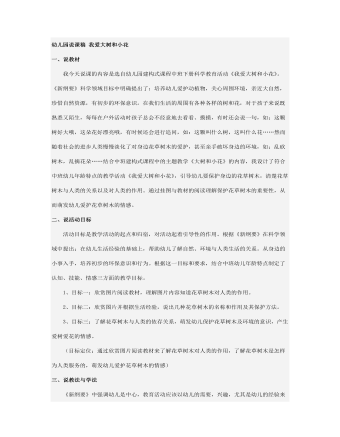
幼儿园说课稿 我爱大树和小花
我今天说课的内容是选自幼儿园建构式课程中班下册科学教育活动《我爱大树和小花》。《新纲要》科学领域目标中明确提出了:培养幼儿爱护动植物,关心周围环境,亲近大自然,珍惜自然资源,有初步的环保意识。在我们生活的周围有各种各样的树和花,对于孩子来说既熟悉又陌生,每每在户外活动时孩子总会不经意地去看看、摸摸,有时还会说一句,如:这颗树好大哦,这朵花好漂亮哦,有时候还会进行追问,如:这颗叫什么树,这叫什么花……然而随着社会的进步人类慢慢淡化了对身边花草树木的爱护,甚至亲手破坏身边的环境,如:乱砍树木,乱摘花朵……结合中班建构式课程中的主题教学《大树和小花》的内容,我设计了符合中班幼儿年龄特点的教学活动《我爱大树和小花》,引导幼儿要保护身边的花草树木,清楚花草树木与人类的关系以及对人类的作用。通过挂图与教材的阅读理解保护花草树木的重要性,从而萌发幼儿爱护花草树木的情感。
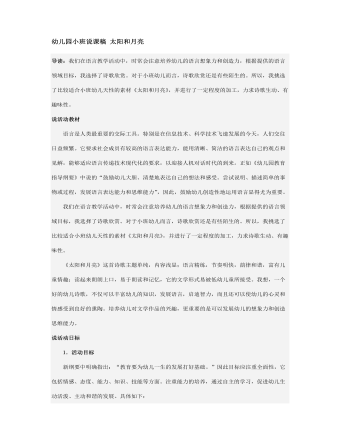
幼儿园小班说课稿 太阳和月亮
语言是人类最重要的交际工具。特别是在信息技术、科学技术飞速发展的今天,人们交往日益频繁。它要求社会成员有较高的语言表达能力,能用清晰、简洁的语言表达自己的观点和见解,能够适应语言传递技术现代化的要求,以迎接人机对话时代的到来。正如《幼儿园教育指导纲要》中说的“鼓励幼儿大胆、清楚地表达自己的想法和感受。尝试说明、描述简单的事物或过程,发展语言表达能力和思维能力”,因此,鼓励幼儿创造性地运用语言显得尤为重要。 我们在语言教学活动中,时常会注意培养幼儿的语言想象力和创造力,根据提供的语言领域目标,我选择了诗歌欣赏。对于小班幼儿而言,诗歌欣赏还是有些陌生的。所以,我挑选了比较适合小班幼儿天性的素材《太阳和月亮》,并进行了一定程度的加工,力求诗歌生动、有趣味性。 《太阳和月亮》这首诗歌主题单纯,内容浅显;语言精练,节奏明快,韵律和谐,富有儿童情趣;读起来朗朗上口,易于朗读和记忆,它的文学形式易被低幼儿童所接受。我想,一个好的幼儿诗歌,不仅可以丰富幼儿的知识,发展语言,启迪智力,而且还可以使幼儿的心灵和情感受到良好的熏陶。培养幼儿对文学作品的兴趣,更重要的是可以发展幼儿的想象力和创造思维能力。
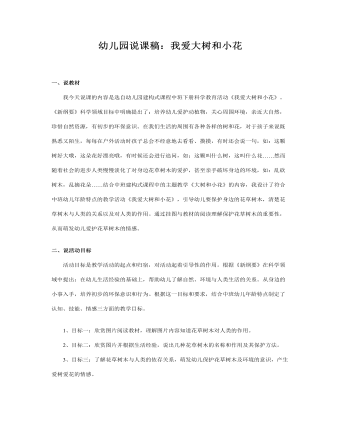
幼儿园中班说课稿:我爱大树和小花
二、说活动目标 活动目标是教学活动的起点和归宿,对活动起着引导性的作用。根据《新纲要》在科学领域中提出:在幼儿生活经验的基础上,帮助幼儿了解自然、环境与人类生活的关系。从身边的小事入手,培养初步的环保意识和行为。根据这一目标和要求,结合中班幼儿年龄特点制定了认知、技能、情感三方面的教学目标。1、目标一:欣赏图片阅读教材,理解图片内容知道花草树木对人类的作用。2、目标二:欣赏图片并根据生活经验,说出几种花草树木的名称和作用及其保护方法。3、目标三:了解花草树木与人类的依存关系,萌发幼儿保护花草树木及环境的意识,产生爱树爱花的情感。 (目标定位:通过欣赏图片阅读教材来了解花草树木对人类的作用,了解花草树木是怎样为人类服务的,萌发幼儿爱护花草树木的情感)三、说教法与学法 《新纲要》中强调幼儿是中心,教育活动应该以幼儿的需要,兴趣,尤其是幼儿的经验来进行,学决定教。在活动中我和幼儿的角色都是教学活动的主人翁,主要是以幼儿为主。让幼儿在教学活动中享受探究问题及解决问题的快乐。所以在教学活动中我采用了“图片观察法”运用直观、形象的图片进行欣赏,引导幼儿理解图片内容及其意思。“游戏法”通过游戏让幼儿亲身体验怎样爱护花草树木让幼儿更深一层的了解爱护花草树木需要做的事情,在游戏中让幼儿学会爱护花草树木的深刻内涵。四、说活动准备 活动中准备:挂图四幅、幼儿用书第37-38页、五幅环保画(例如:树木被破坏、花朵被摘……)、制作花朵大树头饰幼儿人数各一半
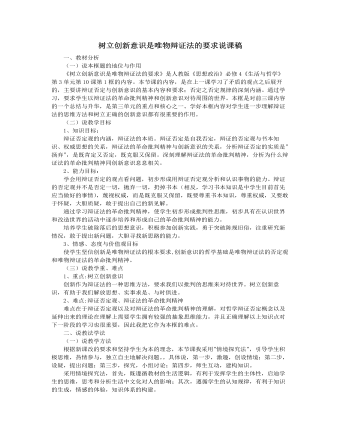
人教版高中政治必修4树立创新意识是唯物辩证法的要求说课稿(一)
(二)说学法指导把“学习的主动权还给学生”,倡导“自主、合作、探究”的学习方式,因而,我在教学过程中特别重视创造学生自主参与,合作交流的机会,充分利用学生已获得的生活体验,通过相关现象的再现,激发学生主动参与,积极思考,分析现象背后的哲学理论依据,帮助学生树立批判精神和创新意识,从而增强教学效果,让学生在自己思维的活跃中领会本节课的重点难点。(三)说教学手段:我运用多媒体辅助教学,展示富有感染力的各种现象和场景,营造一个形象生动的课堂气氛。三、说教学过程教学过程坚持"情境探究法",分为"导入新课——推进新课——走进生活"三个层次,环环相扣,逐步推进,帮助学生完成由感性认识到理性认识的飞跃。下面我重点简述一下对教学过程的设计。

